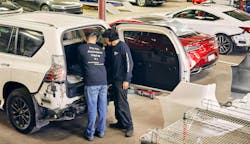Refined Rides: Your Blueprint for Running a Successful Collision Repair Shop
The automotive world is as exciting and fast-paced as the cars it creates. If you want to increase the profits in your shop, you’ll need to lay the groundwork with efficient policies and procedures, plus more effective tactics. But succeeding requires more than just car know-how. As the owner, you’ll need a well-rounded approach that includes excellent customer service, streamlined operations, smart marketing plans and a commitment to always improving your shop – even if it’s making money with a great crew, improvements can be made.
Set Up Your Shop for Success
Location and Layout
Choosing the right location for your shop is one of the most critical decisions you will make. Ideally, the shop should be situated in an area with high visibility and easy access. Proximity to major roads and residential areas can drive customer traffic. This includes the sign you hang outside. Make it large and easy to read so when potential customers drive by on their way home, they can see it effortlessly. So, when they need a body shop in the area, they’ll remember your shop. The layout of the shop should be designed for efficient workflow, with designated areas for different stages of the repair process, such as assessment, disassembly, repair, painting and reassembly. Adequate space for storing parts and vehicles awaiting service is also essential.
Equipment and Tools
Investing in state-of-the-art equipment and tools is crucial for delivering high-quality collision repair services. This includes diagnostic tools, welding machines, paint booths, frame benches, and other specialized equipment. Regular maintenance and calibration of these tools ensure precision and reliability. Additionally, keeping abreast of technological advancements and upgrading equipment as needed can give your shop a competitive edge. This includes the advancement of EVs. They present challenges and opportunities for collision repair shops. Being ahead of the curve with what your business offers is also great for marketing. Be sure to tout the capabilities of your business to current and potential customers.
Operational Efficiency
Streamlining Workflow
Efficiency is key to maximizing productivity and profitability. Implementing a streamlined workflow minimizes downtime and accelerates the repair process. This can be achieved through process-mapping, identifying bottlenecks, and employing lean principles to eliminate waste. Using management playbook software to track key performance indicators (KPIs), employee management actions, productivity of your team and schedule tasks can also enhance your shop’s efficiency.
Quality Control
Maintaining high standards of quality is essential for building a reputation for excellence. Establishing a robust quality control system ensures that every repair meets or exceeds industry standards. This involves regular inspections, testing, and adherence to standardized procedures. Encouraging a culture of accountability and continuous improvement among your team can drive quality and customer satisfaction.
Inventory Management
Effective inventory management ensures that the necessary parts and materials are available when needed, reducing delays and improving service delivery. Implementing an inventory management system can help track stock levels, forecast demand and automate reordering processes. Building strong relationships with reliable suppliers ensures timely delivery of quality parts.
Customer Service
Building Relationships
Excellent customer service is the cornerstone of any successful business but especially for collision shops. Building strong relationships with customers involves clear communication, transparency and delivering on promises. Providing regular updates on the repair process and addressing any concerns promptly enhances customer trust and satisfaction. If a job is being held up for some reason, talk to the customer and tell them why. Being upfront goes a long way with developing long term relationships.
Handling Insurance Claims
Navigating insurance claims can be a complex process for customers. Offering assistance with filing claims, communicating with insurance companies, and providing accurate estimates can simplify the process and enhance the customer experience. Being well-versed in insurance procedures and maintaining good relationships with insurance providers can streamline claim approvals and payment processes.
Follow-Up and Feedback
Following up with customers after service completion demonstrates your commitment to their satisfaction. Soliciting feedback helps identify areas for improvement and provides insights into customer preferences and expectations. Implementing a system for collecting and analyzing feedback can inform service enhancements and foster customer loyalty. Incorporate different platforms for this, for example: texting customers right after job completion, emails for more in-depth information or using the phone to reach people. While many people now prefer texting over phone calls, there are still customers who enjoy hearing a friendly voice on the other end of the call.
Marketing and Branding
Establishing Your Brand
A strong brand identity sets your shop apart from competitors. Developing a distinctive logo, tagline and consistent visual elements creates a memorable brand image. If your logo is a bright blue and yellow, carry that through to your signage, front office, customer emails and website. Highlighting your shop’s unique selling points, such as specialized services, expertise or customer-centric approach, can attract and retain customers.
Online Presence
In today’s digital age, having a robust online presence is essential for reaching a broader audience. A well-designed website showcasing your services, expertise, and customer testimonials builds credibility and trust. Optimizing your website for search engines (SEO) helps improve visibility and attract organic traffic. Engaging with customers through social media platforms and online reviews can enhance your shop’s reputation and foster community engagement. And remember that the frequency of your social media posts needs to be consistent. A successful shop owner knows that posting once every few weeks will not make the business stand out online. Post to your social media platforms at least a few times a week. Highlight specials, your employee’s birthdays, services that your team specializes in…all of that will reinforce your shop with both existing and new customers in your area.
Local Marketing
While online marketing is crucial, local marketing efforts should not be overlooked. Participating in community events, sponsoring local sports teams and collaborating with nearby businesses can increase your shop’s visibility and build a positive local reputation. Offering promotions and discounts to local residents can also drive foot traffic and foster customer loyalty. Offer your business as a car wash space for the local high school fundraiser. This showcases your shop but also reinforces your wish to be involved in the community.
Financial Management
Budgeting and Forecasting
Effective fiscal management is vital for the sustainability and growth of your shop. Developing a comprehensive budget and regularly monitoring expenses and revenue helps maintain financial stability. Forecasting future demand and financial performance enables informed decision-making and strategic planning. Know your KPIs. If you do, you will know the true picture of the financial health of your business. If you don’t, it’s all just a guessing game.
Pricing Strategy
Setting competitive yet profitable pricing is a delicate balance. Conducting market research to understand pricing trends and customer willingness to pay can inform your pricing strategy. Offering transparent and itemized estimates builds trust and helps avoid disputes. Additionally, providing value-added services, such as warranty programs or maintenance packages, can justify premium pricing.
Cost Control
Controlling costs is essential for maintaining profitability. Identifying and eliminating unnecessary expenses, negotiating favorable terms with suppliers and optimizing resource utilization can reduce operational costs. Regular financial audits and performance reviews help identify areas for cost savings and efficiency improvements.
Embrace Technology
Management Software
Investing in management software streamlines various aspects of shop operations, from job tracking and scheduling to invoicing and customer relationship management (CRM). These tools provide real-time insights into operational performance, enabling data-driven decision-making and enhancing overall efficiency.
Digital Communication
Leveraging digital communication tools enhances customer engagement and operational efficiency. Implementing online appointment scheduling, text or email notifications for repair updates and digital payment options streamline the customer experience. Additionally, utilizing customer relationship management (CRM) systems helps track customer interactions and preferences, enabling personalized service.
Continuous Improvement
Training and Development
Investing in the continuous training and development of your team ensures they remain updated with the latest industry trends and repair techniques. Offering regular workshops, certifications and access to online workshops fosters a culture of learning and improvement. Skilled and knowledgeable technicians deliver higher quality service and contribute to customer satisfaction. Plus, employees feel they are being appreciated by the owner investing time and money into their skill level. It’s a win-win for all.
Feedback and Innovation
Encouraging feedback from customers and employees provides valuable insights into areas for improvement. Implementing a system for collecting, analyzing, and acting on feedback promotes a culture of continuous improvement. Additionally, staying informed about industry innovations and adopting new technologies and practices can keep your shop competitive and responsive to market changes.
Sustainability Practices
Incorporating sustainability practices into your operations can enhance your shop’s reputation and appeal to environmentally conscious customers. Implementing energy-efficient lighting, recycling programs and eco-friendly products reduces your environmental footprint. Promoting your commitment to sustainability through marketing efforts can attract a growing segment of eco-conscious consumers.
Running a successful collision repair shop requires a multifaceted approach encompassing operational efficiency, exceptional customer service, effective marketing, financial management and being open to continuous improvement. Ultimately, the key to success lies in delivering high-quality service, fostering customer loyalty and continuously adapting to industry trends and customer expectations.
Remember that the shop owner must work ON the business and not IN the business. If you can achieve that you will reach your goals!
Hear what DRIVE Coach Gibran Munozcano says about what it takes to be a successful collision shop owner:
What do you think are the top 3 reasons a collision repair shop is successful?
Great question! In my experience, the top three reasons a collision shop is successful are:
Quality of Work:
The foundation of any successful collision shop is the quality of their work. This includes everything from the precision of repairs to the final paint job. High standards and attention to detail ensure customer satisfaction and build a solid reputation. Word-of-mouth is incredibly powerful in this industry.
Customer Service:
Exceptional customer service is crucial. This means clear communication, managing customer expectations, and showing empathy. A customer who feels heard and respected is more likely to return and recommend the shop to others. Handling insurance claims smoothly and providing timely updates can significantly enhance the customer experience.
Efficient Operations:
Streamlined processes and efficient use of resources can set the shop apart. This includes everything from the workflow in the shop to inventory management. Investing in the right tools, technology, and training can increase productivity and reduce turnaround times, which ultimately leads to higher profitability and customer satisfaction.
What does a successful owner do or know vs. a not so successful owner?
The difference between a successful owner and a not-so-successful owner often comes down to mindset and practices. A successful owner combines strong leadership, adaptability, and financial acumen to build a resilient and thriving business. They understand that success is a continuous journey of learning, improving, and evolving.
As a DRIVE Coach, why do you love helping shop owners improve their business and life?
I love helping shop owners because it allows me to make a positive difference in their lives and their communities. The journey of improvement and growth is one we embark on together, and seeing them succeed fills my heart with immense pride and Joy.
About the Author

Carolyn Gray
Carolyn Gray of DRIVE has an extensive background in Marketing, Creative, Media Strategy and Branding, including Vice President of Digital at FOX Broadcasting and Co-President of Filmaka Studios. She brings that wealth of knowledge to DRIVE.

